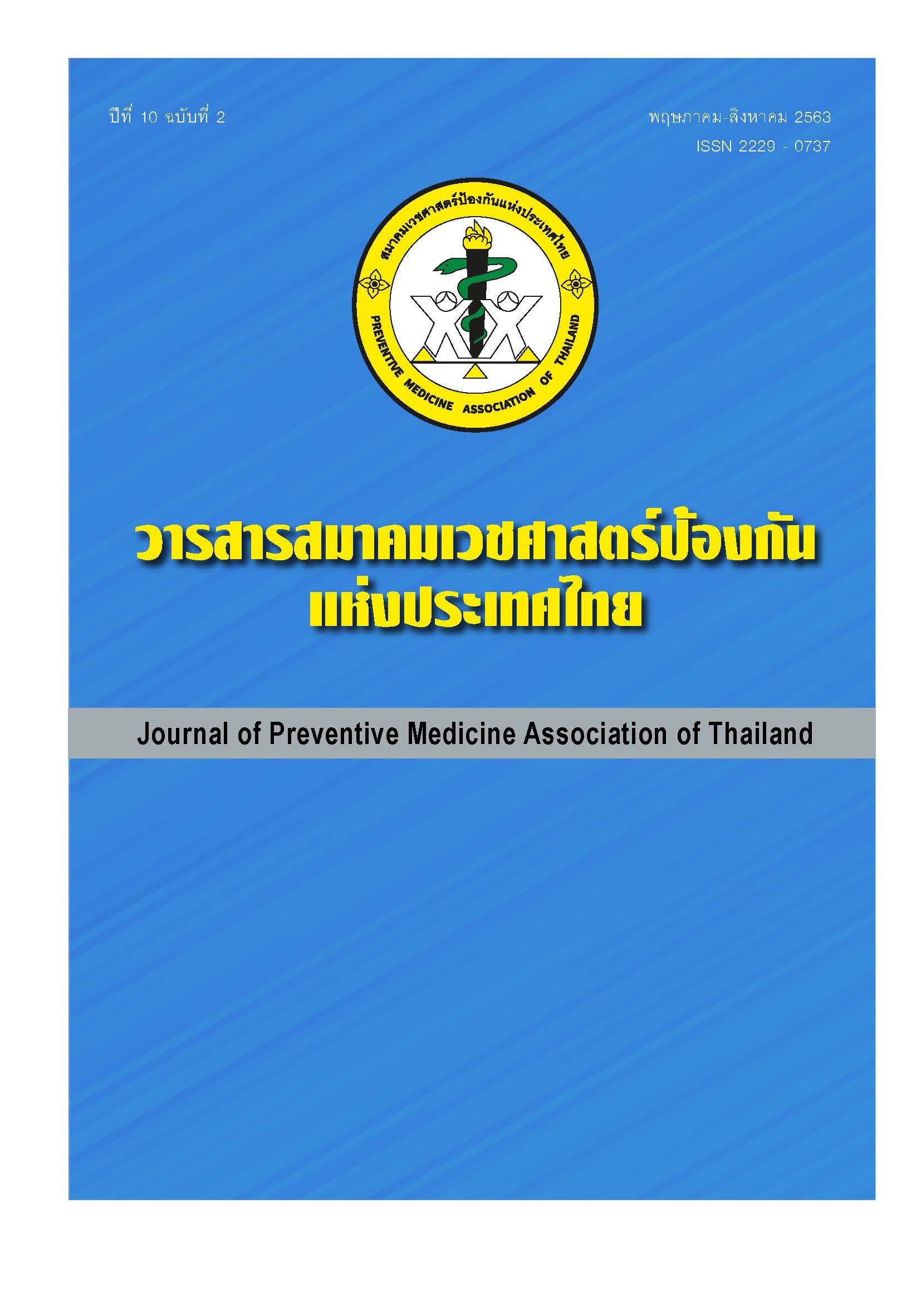ความชุกและปัจจัยที่สัมพันธ์กับภาวะเครียดและซึมเศร้าที่เกิดกับผู้ดูแลผู้ป่วยระยะสุดท้าย เขตพื้นที่ให้บริการของโรงพยาบาลนาน้อย จ.น่าน
คำสำคัญ:
ผู้ป่วยระยะสุดท้าย, ผู้ดูแลผู้ป่วย, ภาวะเครียด, ภาวะซึมเศร้าบทคัดย่อ
การศึกษานี้เป็นการศึกษาเชิงวิเคราะห์ภาคตัดขวางในช่วงเวลาใดเวลาหนึ่ง (Cross-sectional analytic study) เพื่อหาความชุกของภาวะเครียดและซึมเศร้าที่เกิดกับผู้ดูแลผู้ป่วยระยะสุดท้าย ตลอดจนศึกษาปัจจัยที่มีความสัมพันธ์กับภาวะเครียดและซึมเศร้านั้นในเขตพื้นที่รับผิดชอบของโรงพยาบาลนาน้อย กลุ่มตัวอย่างคือผู้ดูแลหลักของผู้ป่วยระยะสุดท้ายตามเกณฑ์ของกรมการแพทย์ 9 กลุ่มโรค เก็บข้อมูลโดยการสัมภาษณ์ เครื่องมือที่ใช้คือแบบสอบถามข้อมูลทั่วไป แบบประเมินความเครียด (ST-5) แบบคัดกรองซึมเศร้า 2 คำถาม (2Q) และแบบประเมินความรุนแรงของภาวะซึมเศร้า 9 ข้อ (9Q) ของกรมสุขภาพจิต ผลการศึกษาพบกลุ่มตัวอย่างร้อยละ 88.7 มีภาวะเครียด โดยมีภาวะเครียดเล็กน้อยซึ่งสามารถพบได้ในบุคคลทั่วไปร้อยละ 68.6 มีภาวะเครียดปานกลางร้อยละ 15.3 มีภาวะเครียดมากและมากที่สุดร้อยละ 4.0 และ 0.8 ตามลำดับ ปัจจัยที่มีผลต่อภาวะเครียดของผู้ดูแลพบว่า การสูญเสียโอกาสทางสังคม การลดลงของรายได้ โรคของผู้ป่วยที่ดูแลอยู่ และการมีผู้ดูแลร่วมบางครั้ง เป็นปัจจัยที่ทำให้เกิดความเครียดมากขึ้นอย่างมีนัยสำคัญทางสถิติ ปัจจัยที่มีผลให้เกิดความเครียดมาก (ST-5 score > 4) คือ การดูแลผู้ป่วยสูงอายุที่มีอาการสมองเสื่อมมีคะแนนความเครียดเฉลี่ยสูงที่สุดคือ 4.22 รองลงมาคือปัจจัยด้านรายได้ของผู้ดูแลอยู่ระหว่าง 5,000-10,000 บาทต่อเดือนมีค่าคะแนนความเครียดอยู่ที่ 4.03 ในส่วนของภาวะซึมเศร้าพบความชุกของภาวะซึมเศร้าร้อยละ 5.6 ปัจจัยด้านรายได้ของผู้ดูแลมีผลต่อการเกิดภาวะซึมเศร้าอย่างมีนัยสำคัญทางสถิติโดยกลุ่มผู้ดูแลที่มีรายได้เฉลี่ยสูงจะมีภาวะซึมเศร้าสูง ผู้มีรายได้ระหว่าง 10,000-15,000 บาทต่อเดือนมีความชุกของภาวะซึมเศร้ามากที่สุดคือร้อยละ 33.3 ผู้ที่มีรายได้มากกว่า 15,000 บาทต่อเดือนมีภาวะซึมเศร้าร้อยละ 25 ส่วนผู้ที่มีรายได้ระหว่าง 5,000-10,000 และน้อยกว่า 5,000 บาทต่อเดือนพบมีภาวะซึมเศร้าเพียงร้อยละ 6.1 และ 2.8 ตามลำดับ การเปรียบเทียบภายในกลุ่มของแต่ละปัจจัยพบว่าคะแนนความเครียดกลุ่มผู้ดูแลผู้ป่วยสูงอายุที่มีอาการสมองเสื่อมจะสูงกว่ากลุ่มผู้ดูแลผู้ป่วยโรคไตระยะสุดท้ายและโรคถุงลมโป่งพองระยะท้ายอย่างมีนัยสำคัญทางสถิติ ปัจจัยด้านการสูญเสียรายได้พบว่าผู้ที่รายได้ลดลงร้อยละ 25-50 มีคะแนนความเครียดสูงสุดและสูงกว่าผู้ที่รายได้ไม่ลดลงเลยอย่างมีนัยสำคัญทางสถิติ ส่วนการมีผู้ดูแลร่วมพบว่าการที่มีผู้ดูแลอื่นร่วมบางเวลามีผลต่อภาวะเครียดสูงสุดและสูงกว่าการมีผู้ดูแลร่วมประจำอย่างมีนัยสำคัญทางสถิติ และพบว่าการสูญเสียโอกาสในการเข้าร่วมกิจกรรมทางสังคมมีคะแนนความเครียดสูงอย่างมีนัยสำคัญทางสถิติ
เอกสารอ้างอิง
2. Andershed B. Relatives in end-of-life care - part 1: A systematic review of the literature the five last years, January 1999-February 2004. J Clin Nurs 2006;15:1158-69.
3. Brazil K, Bedard M, Willison K, Hode M. Caregiving and its impact on families of the terminally ill. Aging Ment Health 2003;7:376-82.
4. Hauser JM, Kramer BJ. Family caregivers in palliative care. Clin Geriatr Med 2004;20:671-88.
5. Kristjanson LJ, Aoun S. Palliative care for families: remembering the hidden patients. Can J Psychiatry 2004;49:359-65.
6. Payne S, Smith P, Dean S. Identifying the concerns of informal carers in palliative care. Palliat Med 1999;13:37-44.
7. Barg FK, Pasacreta JV, Nuamah IF, Robinson KD, Angeletti K, Yasko JM, et al. A description of a psychoeducational intervention for family caregivers of cancer patients. J Fam Nurs 1998;44:394-413.
8. Kellehear A. Understanding the social and cultural dimensions of family caregiving. In Hudson P, Payne S, Editers. Family Carers in Palliative Care A Guide for Health and Social Care Professionals. New York: Oxford University Press; 2009. P.21-36.
9. พชรมณฑ์ ลำเลียงพล. ภาวะซึมเศร้าวิตกกังวลและคุณภาพชีวิตในผู้ดูแลผู้ป่วยสมองเสื่อม.วารสารสุขภาพจิตแห่งประเทศไทย 2558;23:112-24.
10. ธิติพันธ์ ธานีรัตน์, เยาวลักษณ์ พนิตอังกูร, ตันติมา ด้วงโยธา, อุบุญรัตน์ ธุรีราช, ปิยนุช กิมเสาว์. ความชุกของภาวะซึมเศร้า วิตกกังวลและปัจจัยที่เกี่ยวข้องในผู้ดูแลหลักของผู้ป่วยจิตเวชสูงอายุ. วารสารสมาคมจิตแพทย์แห่งประเทศไทย 2559;61:319-30.
11. เชิดชาย ชยวัฒโฑ. การศึกษาภาวะซึมเศร้าในผู้ดูแลผู้ป่วยโรคอัมพาตหลอดเลือดสมอง.วารสารแพทย์เขต 4-5 2559;35:14-27.
12. กรมการแพทย์. List disease of Palliative care and Functional unit. กรุงเทพฯ:สำนักวิชาการแพทย์ กรมการแพทย์ กระทรวงสาธารณสุข; 2559.
13. กรมสุขภาพจิต กระทรวงสาธารณสุข.แนวทางการใช้เครื่องมือด้านสุขภาพจิตสำหรับบุคลากรสาธารณสุข
ในโรงพยาบาลชุมชน(คลินิกโรคเรื้อรัง) ฉบับปรับปรุง.กรุงเทพฯ:สำนักส่งเสริมและพัฒนาสุขภาพจิต กรมสุขภาพจิต; 2558.
14. ธรณินทร์ กองสุข, สุวรรณา อรุณพงค์ไพศาล, ศุภชัย จันทร์ทอง, เบญจมาศ พฤกษ์กานนท์, สุพัตรา สุขาวห, จินตนา ลี้จงเพิ่มพูน. ความเที่ยงตรงตามเกณฑ์การวินิจฉัยโรคซึมเศร้าของแบบประเมินอาการซึมเศร้า 9 คำถาม. วารสารสมาคมจิตแพทย์แห่งประเทศไทย 2561;63:321-34.
15. สาสินี เทพสุวรรณ์, ณัฐจีรา ทองเจริญชูพงศ์, รศรินทร์ เกรย์. ปัจจัยที่ส่งผลต่อความเครียดและความสุขของการดูแลผู้สูงอายุ. วารสารประชากร 2555-2556;4(1):75-92.
16. นภา พวงรอด. การศึกษาภาวะซึมเศร้าของผู้สูงอายุในจังหวัดนนทบุรี. วารสารมหาวิทยาลัยนราธิวาสราชนครินทร์ 2558;1:63-74.
ดาวน์โหลด
เผยแพร่แล้ว
รูปแบบการอ้างอิง
ฉบับ
ประเภทบทความ
สัญญาอนุญาต
บทความที่ลงพิมพ์ในวารสารเวชศาสตร์ป้องกันแห่งประเทศไทย ถือเป็นผลงานวิชาการ งานวิจัย วิเคราะห์ วิจารณ์ ตลอดจนเป็นความเห็นส่วนตัวของผู้นิพนธ์ กองบรรณาธิการไม่จำเป็นต้องเห็นด้วยเสมอไป และผู้นิพนธ์จะต้องรับผิดชอบต่อบทความของตนเอง






